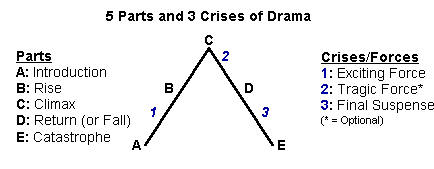

Act
I: Exposition, Exciting
Force,
Rising Action
Act
II:
Rising Action
Act
III:
Rising Action, Climax,
Falling Action
Act
IV:
Falling Action
Act
V:
Falling Action, Catastrophe
The exposition describes the mood and conditions existing at the beginning of the play. The time and place will be identified as well as the main characters and their positions, circumstances, and relationships to one another.
Exciting Force
Also sometimes called the complication or initial incident, the exciting force is what “gets things going.” The exciting force thus begins the conflict which will continue throughout the play.
Rising Action
The series of events leading to the climax comprise the rising action. These events provide a progressive intensity of interest for the audience. The rising action will involve more than one act.
Climax
The climax represents the turning point of the play. From this point on, the Shakespearean hero moves to his inevitable (often grisly) end.
Falling Action
The falling action includes those events occurring from the time of the climax up to the hero’s death. The episodes will show both advances and declines in the various forces acting upon the hero. The catastrophe concerns the necessary consequences of the hero’s actions (death). The catastrophe will be characteristically simple and brief.
No comments:
Post a Comment